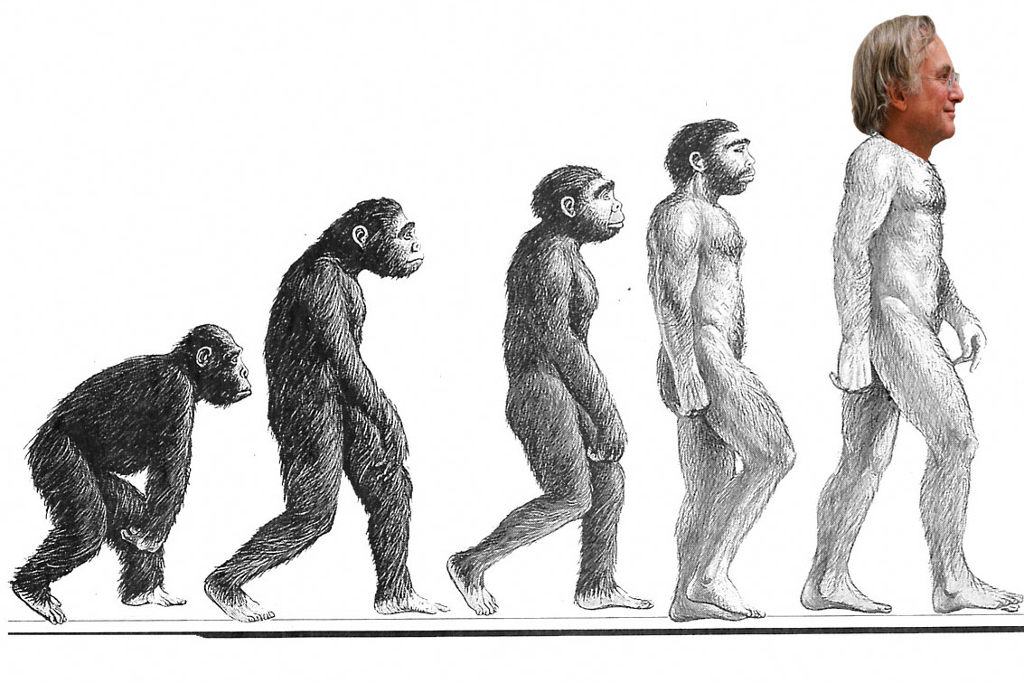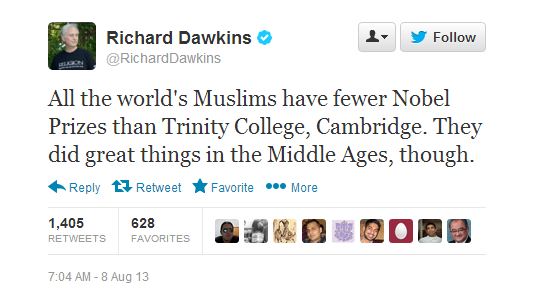The Five Ages Of Richard Dawkins
One man’s evolution from humble biologist to misanthropic übertroll.

Last week, celebrity Atheist Richard Dawkins, apropos of nothing in particular, sent out the following tweet:

As an entirely predictable shitstorm erupted (sample responses: “Your a dick” – @daleof; “Dawkins haters could learn a lot if they didn’t shield themselves behind a wall of PC” – @Chriss_m), I found myself wondering how a full-time Twitter troll could have racked up almost 800,000 followers. Then I remembered that Dawkins used to write books.
If you find it difficult to cast your mind that far back, allow us to remind you of all the good, useful contributions that Dawkins made to the world, prior to his descent into smug bigotry. It’s been a slow, almost imperceptible transition, so we thought we’d look back at some of his milestone moments.
–
Richard Dawkins: mild-mannered evolutionary biologist
The Selfish Gene, published in 1976, was a work of scientific rigour. Dawkins, still a bona fide evolutionary biologist at this point, proposed that natural selection occurred not only at the level of the species or the individual, but at a genetic level. RIGHT NOW! IN YOUR BONES!
It was a notable contribution, and Dawkins continued in this vein through 1982’s The Extended Phenotype, before moving into his ‘what’s up with God?’ phase with The Blind Watchmaker in 1986.
Note: as well as offering an exposition of this theory, the below video draws a bold, montage-based parallel between politicians and territorial zebras.
(Bonus fact: Dawkins invented the concept of the meme. No, not that meme; this one)
–
Richard Dawkins: public intellectual
Already a noted thinker, The God Delusion (2006) represented Dawkins’ biggest-yet hit from the fame bong. As the work of a public intellectual writing for a mass audience, Dawkins went broad, speculative and polemical. In building a philosophical worldview out of his early scientific observations, he was able to rest his rather aggressive atheist advocacy on solid foundations, giving free-thinking teens and young adults the opportunity to sneer at the feeble-mindedness of believers.
The book sold like highly-evolved hotcakes, and for a while there, Dawkins was an even bigger deal than Michael Moore (remember Michael Moore?). Needless to say, he encountered a fair degree of hostility as well, namely for lacking sufficient knowledge of the religions that he criticised (theologian Alister McGrath), and for criticising them with such condescension as to alienate those that might have been converted to his cause (astrophysicist Martin Rees).
–
Richard Dawkins: curmudgeon
Many believed that this would represent the last phase of Dawkins’ journey. Over the latter half of the last decade, Dawkins began to embrace his figurehead status, becoming a freelance lightning rod for any cause that fell within his atheist/humanist sweet spot.
2009’s The Greatest Show On Earth sold very respectably, but was overshadowed by Dawkins’ activism, including such initiatives as an atheist bus campaign and a self-titled charitable foundation. This activism was overshadowed, in turn, by his increasingly militant public presence, as evinced during his April 2010 appearance on Q&A with Cardinal George Pell.
It’s always fun to watch two crotchety old men have it out, barely listening to one another while failing to conceal their mutual disdain. More importantly though, Dawkins’ adoption of the ‘LALALA I CAN’T HEAR YOU’ rhetorical approach in this infamous episode marked the moment when his dogmatism became scarcely distinguishable from that of the religious figures he so derided. Behold.
If you find all the circular logic and crankiness a tad depressing, try picturing Pell and Dawkins in singlets, leaning against a fence. Substitute “that kid of yours” for “religion”, and “your bloody dog” for “Atheism” and you can not only cheer yourself up a bit, but get a rough analogue for the quality of the debate.
–
Richard Dawkins: hassler of rock stars
Taking The Killers’ frontman Brandon Flowers to task on the logical inconsistencies of Mormon doctrine is like taking candy from a baby seal in a barrel. This cringeworthy exchange, which took place in September 2012 on a Norwegian talk show, bore evidence that Dawkins had started to wield reason not as a wand of enlightenment, but as an avenging blade of jerkery.
The magic lies in the way that Dawkins maintains his tone of condescending benevolence as he patiently (okay, impatiently) listens to Flowers explain the sense of joy and deep contentment that his faith affords him, before attempting to painstakingly dismantle that self-same belief system, like a child removing wings from a fly.
–
Richard Dawkins: trolling idiot

That tweet. Thursday August 8 2013 was the date when Richard Dawkins drank the bong-water of Twitter notoriety. Obviously, Dawkins was “simply stating an intriguing fact”. Facts never did any harm to anyone, right?
Who could be offended by plain old selectively-chosen facts, decontextualised and seemingly designed to casually dismiss the last 600 years of Islamic endeavour?
Who could be upset when an incredibly privileged white guy casually implies that a select body of other privileged white guys hold absolute authority in determining the human worth of an entire faith?
It’s not Richard Dawkins’ fault that he’s right and 1.57 billion Muslims are wrong, is it? Is it? Poor Richard…
–
Epilogue — Richard Dawkins: Emma Watson Doppelgänger
This isn’t really relevant, but you ought to see it anyway.

No words.
–
Edward Sharp-Paul is a freelance writer and drink-pourer from Melbourne. He mostly likes music and the sportz, and his words can be found at FasterLouder, Mess+Noise, Beat and The Brag. He also runs his mouth off under the cunning alias @e_sharppaul.
